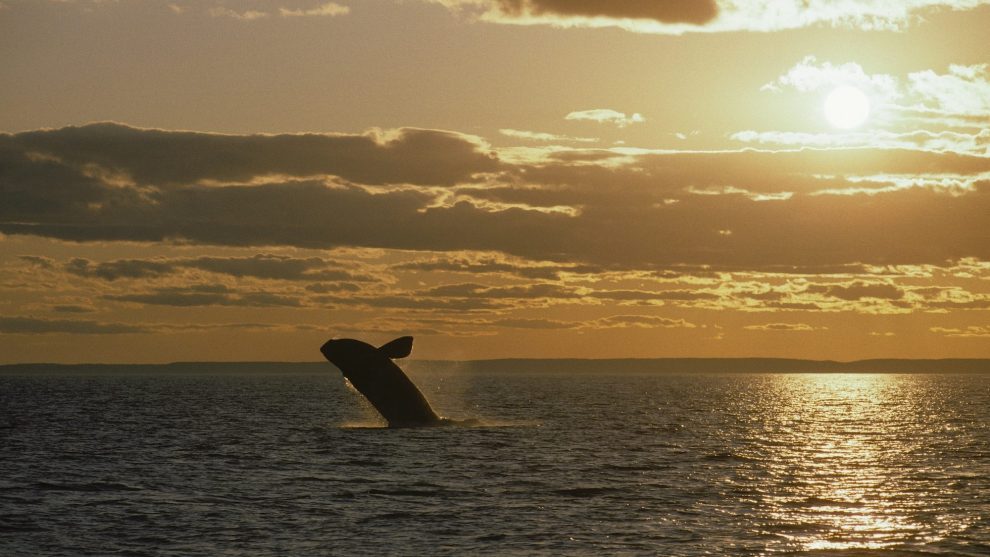Humpbacks Breaching!
A behaviour observed in Cetaceans is breaching. Humpback whales are among the species of Cetaceans that breach and one of the few species that breach regularly. A breach is when a whale is able swim rapidly towards the surface of the water and initially leaves the water vertically before the whale falls back to the water. Our cover image shows a Humpback whale engaged in a breach and almost completely out of the water. The ventral side of whale is shown with barnacles near the chin and the pleats that allows the Humpback to expand its mouth to engulf a large volume of water with its prey.
A number of Humpback whales were seen around Powell River and the north end of Texada Island. Many Transient Orca were seen in various inland waterways and on at least two occasions, the Transient Orca were observed hunting (sea lions and dolphins). Rounding our report are a few sightings of Harbour porpoises and Pacific White-Sided dolphins.
In our magazine section, read about the discovery of a new species of Beaked whales and learn how pilot whales mimic the sounds of their predators.
The Federal Government (DFO) has issued the following statement about watching whales in the wild: “To address disturbance in the presence of whales, a mandatory 400-metre vessel approach distance for all killer whales is in effect starting June 1, 2020 in all southern British Columbia coastal waters between Campbell River and just north of Ucluelet. The Marine Mammal Regulations continue to remain in effect year-round, including maintaining a minimum 200 metre approach distance from all killer whales in Canadian Pacific waters other than described above, and 100 metres for other whales, porpoises and dolphins OR 200 metres when the animal is in resting position or with a calf.”
WOWs works throught the year, so please continue to keep your eyes open, and report your sightings to us.
Archive Explorer navigates 25,000+ Cetacean Sightings, images, videos and audio recordings. Please use the the funnel in our Map for access to our huge range of filters. Those wishing Research information in a spreadsheet format, please Click Here
*Recommended for desktop browsers and newer mobile devices
Archive Explorer dives into the Coastal Cetacean world. View Cetacean sighting locations, photos and videos:
- All species including Orca, Humpback, Grey Whale or Dalls Porpoise
- Follow the endangered Southern Residents Orca in the Salish Sea
- Search for encounters with T002C2 Tumbo
- Witness a close-up Orca encounter video in Port Alberni harbour
- Follow the T010s Transients as they hunt and travel the inside passage
- Track “KC”, the ever popular Humpback’s movements
- Locate any of 12,000+ named locations on the BC and WA State coast
- Print custom sighting reports and maps (Coming Soon)
Archive Explorer Help Page explains many advanced functions
Send your Comments and Questions to: Archive Explorer Feedback
To access 25,000+ sightings in our database in a downloadable csv file for use in a research spreadsheet, please Click Here.
A humpback whale has been frequenting Ketchikan, Alaska, almost daily for the past month, helping to lift spirits as the city reels from a lack of tourism.
The whale, nicknamed Phoenix, is feeding on herring and possibly salmon fry with dramatic upward lunges, sometimes just yards from onlookers on docks and walkways….
read on
Ensenada, BCN, Mexico – Dec. 8, 2020 – Researchers working with Sea Shepherd Conservation Society believe that they have discovered a previously unknown species of whale off the western coast of Mexico.
On the morning of November 17, scientists on board Sea Shepherd vessel Martin Sheen observed three beaked whales surfacing in nearby waters. The sightings occurred 100 miles north of Mexico’s San Benito Islands, a group of three remote islands located approximately 300 miles from the US border….
read on
Marine mammals stranded on beaches in the southeastern United States died with high levels of pollutants stored in their organs and blubber, researchers reported recently in Frontiers in Marine Science.
“Marine mammals are like a litmus test for the ecosystem,” said lead author Annie Page-Karjian, clinical veterinarian at Harbor Branch Oceanographic Institute, Florida Atlantic University. “Looking at them and the toxins they’re exposed to gives us a snapshot of what is happening in the marine environment.”…
read on
read on
read on







